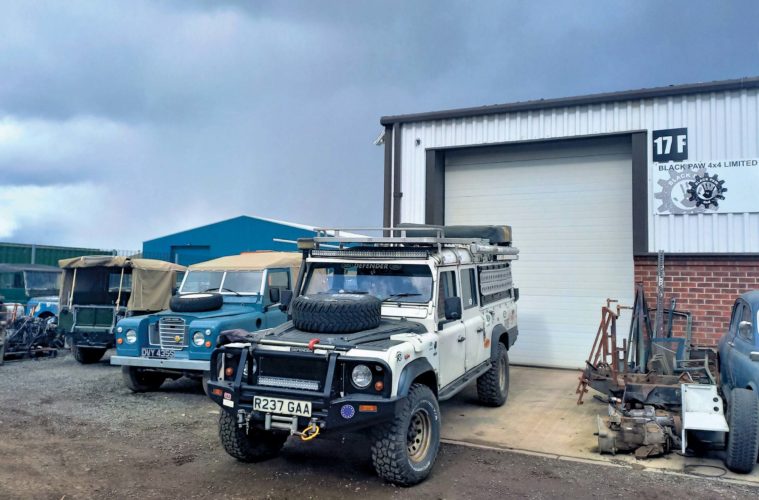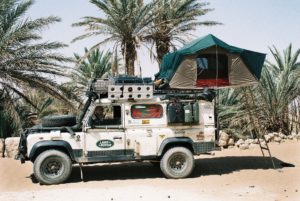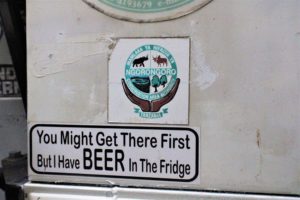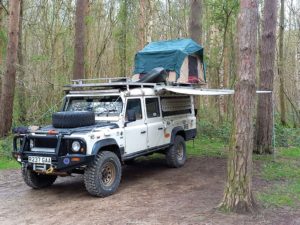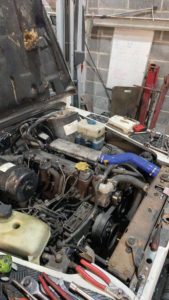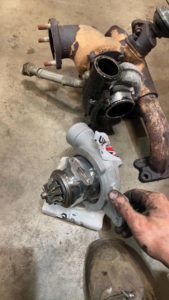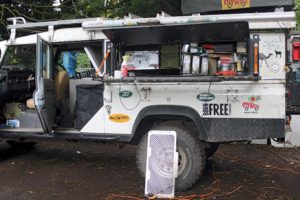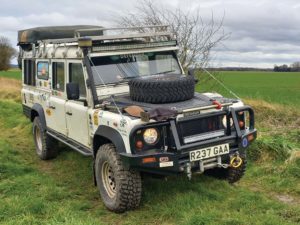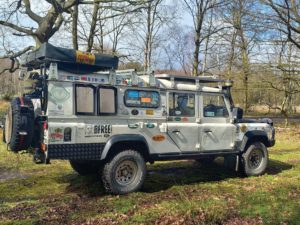What do you do when Elsa, your much-loved ’91 Defender 110 200 Tdi reaches 400,000 reliable miles and starts to show her age? Your head says, “Replace her.” Your heart disagrees. The two argue. In my internal debate, the heart pulled a cunning move that carried the day. This was, “Isn’t it better to stick with a reliable vehicle you already know well, and simply rebuild it than embark on the sea of unknowns in a new-to-you but ‘used’ Land Rover?” (It would have to be used and “of a certain age” – I don’t want electronics in a remote-area overland vehicle). This swayed me, combined with the current nutso prices of Defender L316s on both sides of the Pond. A rebuild it was.
Elsa, the 1991 110 in question, has traveled with me for over twenty years – from my home base in the UK around bits of Africa, the Middle East, and Europe, always as a hard-top 110 with two seats. Often during those two decades, I’ve regretted not having extra seats – cramming friends, family, hitchhikers, and so on into the rear load area and the ergonomically challenged rear benches. Yet I wanted that full 110 rear load bay intact as a possible sleeping area in foul weather or where “stealth camping” was needed. So, what to do?
I’m lucky enough to be a customer of Ben Stowe at Black Paw 4×4 in the UK (Ben – a desert overlander himself – rebuilt Oxford, the “First Overland” Series 1, as well as his own Camel Trophy 110 and countless other overland trucks.) We chatted about Elsa’s rebuild options, one of which concerned the need for a dual-use rear space – decent seating and a sleeping area. “Well, that’s okay,” said Ben, “let’s stretch her to a 130 and make her into a Station Wagon Hard Top.”
Gulp.
Okay… how do we do this?
British law says you can’t just chop the frame and add twenty inches. I know of a 90 that was converted to a 110 like this in Kenya but this isn’t legal in the UK. (Most likely this Land Rover 90, has done more Cairo-Cape Town crossings of Africa than any other vehicle.) So I needed a donor 130 which would yield a frame, and then we would transplant all of Elsa’s bodywork and equipment onto the “new” frame and add an extra row of seats and doors. By chance, a friend with two matching 130 crew cabs (one of which I’d borrowed five years before as a long-term loaner) had decided to sell one of his twin sister trucks – so I snapped it up at “mates’ rates” – in other words, he did me a deal.
The donor 130 was an ex-Southern Scotland Electricity Company truck, a crew cab with a separate fiberglass rear cabin, and a 300tdi. Ideal: the 110 and 130 all got taken to Black Paw for surgery. With both bodies off the frames, we took stock. The first job was to try all the body parts on the 130 frame. It was important to me to retain Elsa’s identity with her rather battered, scarred body panels – each dent tells a story! The transplant was a lot more straightforward than expected. The 110’s nose, front row of doors and seats (from the 110), the second row of doors and seats (from the 130) plus the 110 rear hardtop body, all dry-fitted together, came to almost exactly the same length as the crew cab plus rear box cabin unit. The only issue was the location of the wheel arches on the rear tub bodywork, which are in different places for the 130 and 110. Black Paw did an excellent job of seamlessly moving these to the desired new locations, while at the same time building an extension to the frame at the rear. I decided I wanted a swing-away rear spare wheel carrier that also mounted twin jerrycan racks. On the existing 130 frame, there is no rear crossmember positioned in such a way to allow this, so Ben built an extension to the chassis with an additional rear crossmember ready to receive the wheel carrier, which he also fabricated. I decided at this stage to use the 110 frame and 200 Tdi, together with leftover body panels and a pickup rear tub that Ben had lying about, to build a “bitsa” soft-top truck, which would be a cool side project.
We retained the 130’s 300 Tdi for the conversion, keeping the older 200 Tdi for the 110 “bitsa,” but fitted a hybrid turbo to the 300. Not in a quest for higher top speeds, but for more torque and better fuel economy for greater range in long, unsupported desert drives. At the same time, following a review of the engine, I had a tropical-spec extra-thick radiator made up to increase the cooling capability – the truck will be doing a lot of Saharan drives and with the extra weight, this seemed a must-have. An Allisport intercooler completed the engine modifications – again in a quest for efficiency and lower running temperatures.
Engine sorted, the next job was suspension. As a 110, Elsa had recently been running Camel Trophy-spec coil-within-coil springs mated to DeCarbon dampers. Before this, she’d been fitted with air helper springs inside Heavy Duty 110 coils, but the buildup of Saharan sand after many desert trips had abraded the airbags until one burst in an Algerian oasis, causing an alarming three-inch tilt. In short, the existing system needed beefing up. The Camel springs were fine, but she needed new dampers. We chose Fox Racing remote-reservoir shocks with a twin damper mounting at the rear on each side to support the extra length, flex, and weight of the rear body.
I needed to fit some sort of bullbar and winch bumper, as Elsa’s existing unit was twenty years old and very tatty. An ARB bullbar was mated to a Warn XD9000 winch, which was then fitted to the 130. The bullbar needed quite a bit of modification to accept the winch, which was fitted on its side. We also had to cut the bodywork to make the winch spool fit – not ideal (and rather annoying), but in the end, it all worked. Obviously, a 9,000lb winch isn’t really strong enough for a big truck like the 130 in the worst of conditions, so a replacement will happen in the medium term. I kept a wire rope for the winch, as these degrade less in desert sand than synthetics. Rock sliders were fitted – custom-made ones to suit the length of the 130 – as were a variety of underbody guards. The ramp breakover angle was going to be compromised with the new body length, and I wanted her vitals protected!
The big overhang at the rear, plus the weight of the spare tire and twin jerrycans was starting to cause a weight imbalance issue. The original Lode Lane design hadn’t envisaged such a lot of mass hanging beyond the rear axle, so to counteract any instability, we decided to try and bring the center of gravity forward and lower down. Various heavy bits of safari gear – the Hi-Lift and freshwater tanks, for example, were brought forward of the rear axle. As a 110, Elsa had been fitted with two layers of Front Runner storage sliders for Wolf Cub boxes, and these would be rearward of the back axle on the 130 body. Steel framed, these are not light even when empty, so I removed one layer and transferred it to the bitsa 110 pickup, which was now evolving into an overland vehicle in its own right.
The “dead space” under the rear seats in the 130 crew cab became a storage bin for heavy spares, starter motor, alternator, and so on, and 40 liters of drinking water storage was moved from a tank in the rear body to a flat tank in the footwell of the second row of seats. Finally, I moved the Engel fridge forward. The rear row of seats has the 1/3 to 2/3 split seen on older Defenders, and I removed the smaller seat section, making a fridge cradle there instead. Access to the huge rear storage space was increased by a custom-made gullwing side hatch from the excellent Rhino Overland in Turkey, and this also gave access to the new third battery – we now linked the two under-seat batteries in parallel as a starter “battery” and fitted a deep-cycle auxiliary battery in the rear body.
Things were looking good. Small details were not forgotten – transom steps from yacht outfitters gave unobtrusive, fold-flat roof access. The raised air intake was moved from one side of the engine (old 200tdi) to the other side (new 300 Tdi). Black Paw fitted a hard-wired Viair compressor in a custom underwing mount. Camp Cover from South Africa provided useful storage bags around the vehicle. Exmoor Trim canvas seat covers provided protection to the seating. Elsa’s old MyWay roof tent was still perfectly fine, so that went back on top of Front Runner roof bars allied to a Front Runner rack from a 110. Wide, chunky BFG 285 MTs went on each corner to give much-needed stability and traction, and a shakedown test run around the western Highlands of Scotland suggested everything was working. The extra size and weight were accounted for, and stability seemed excellent, as did engine heat under load. Elsa’s ready for the Sahara…
